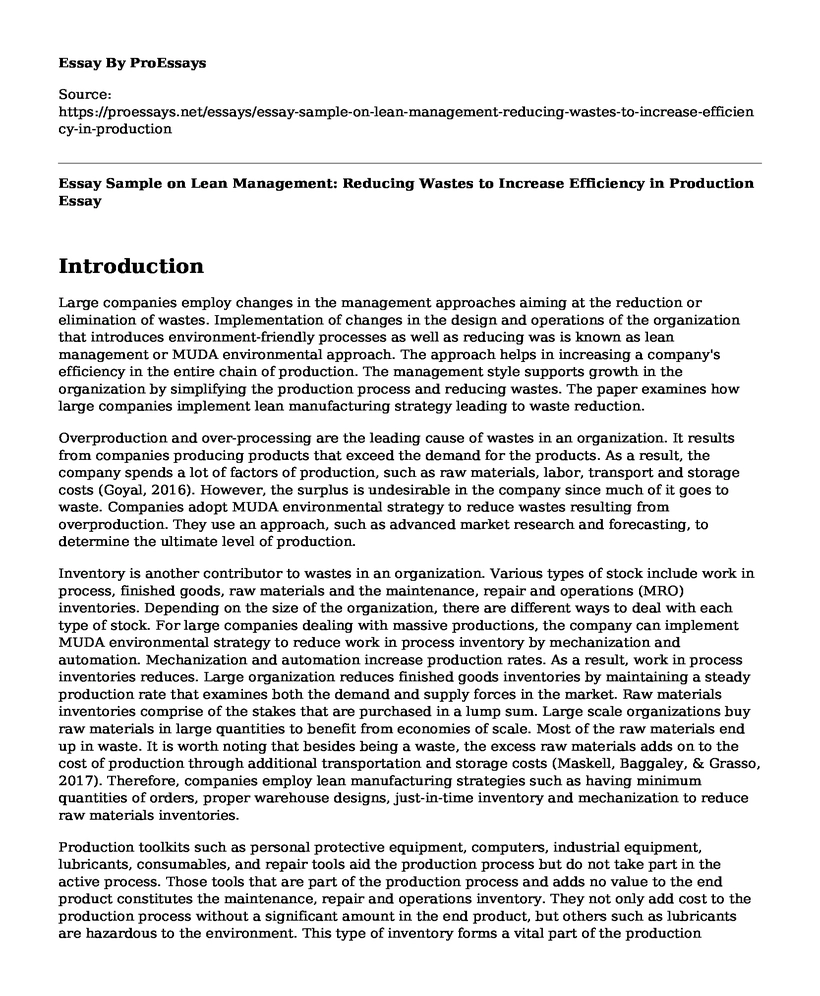Introduction
Large companies employ changes in the management approaches aiming at the reduction or elimination of wastes. Implementation of changes in the design and operations of the organization that introduces environment-friendly processes as well as reducing was is known as lean management or MUDA environmental approach. The approach helps in increasing a company's efficiency in the entire chain of production. The management style supports growth in the organization by simplifying the production process and reducing wastes. The paper examines how large companies implement lean manufacturing strategy leading to waste reduction.
Overproduction and over-processing are the leading cause of wastes in an organization. It results from companies producing products that exceed the demand for the products. As a result, the company spends a lot of factors of production, such as raw materials, labor, transport and storage costs (Goyal, 2016). However, the surplus is undesirable in the company since much of it goes to waste. Companies adopt MUDA environmental strategy to reduce wastes resulting from overproduction. They use an approach, such as advanced market research and forecasting, to determine the ultimate level of production.
Inventory is another contributor to wastes in an organization. Various types of stock include work in process, finished goods, raw materials and the maintenance, repair and operations (MRO) inventories. Depending on the size of the organization, there are different ways to deal with each type of stock. For large companies dealing with massive productions, the company can implement MUDA environmental strategy to reduce work in process inventory by mechanization and automation. Mechanization and automation increase production rates. As a result, work in process inventories reduces. Large organization reduces finished goods inventories by maintaining a steady production rate that examines both the demand and supply forces in the market. Raw materials inventories comprise of the stakes that are purchased in a lump sum. Large scale organizations buy raw materials in large quantities to benefit from economies of scale. Most of the raw materials end up in waste. It is worth noting that besides being a waste, the excess raw materials adds on to the cost of production through additional transportation and storage costs (Maskell, Baggaley, & Grasso, 2017). Therefore, companies employ lean manufacturing strategies such as having minimum quantities of orders, proper warehouse designs, just-in-time inventory and mechanization to reduce raw materials inventories.
Production toolkits such as personal protective equipment, computers, industrial equipment, lubricants, consumables, and repair tools aid the production process but do not take part in the active process. Those tools that are part of the production process and adds no value to the end product constitutes the maintenance, repair and operations inventory. They not only add cost to the production process without a significant amount in the end product, but others such as lubricants are hazardous to the environment. This type of inventory forms a vital part of the production process. However, companies strive to regulate the level of these inventories. Large companies employ MUDA environmental models such as reuse and recycle to reduce costs on this type of stock.
Other types of inventories include transportation, motion, and waiting stocks. These inventories occur when there is a bottleneck in the production process that stops the production cycle momentarily. As a result, one or more operations are delayed as they await the upstream side to complete. Large companies minimize and reduce these types of inventories by the use of robotics, automation and mechanization. Transportation gears such as conveyors, Automated Guarded Vehicles (AGV), and robots help in eliminating transportation, motion and waiting inventories.
Conclusion
In conclusion, lean manufacturing strategies helps in the elimination of inventories and wastes. MUDA environmental strategy helps in the reduction of overproduction, over-processing, and inventories such as raw material, work in process, finished goods and the MRO inventories. Elimination of wastes helps in increasing production rates, lowering production costs as well as creating a green environment by eliminating environmental hazards.
References
Goyal, M. (2016). Integration of Building Information Modeling (BIM) and Prefabrication: A Boost to Lean Principle Environment (Doctoral dissertation, North Dakota State University).
Maskell, B. H., Baggaley, B., & Grasso, L. (2017). Practical lean accounting: a proven system for measuring and managing the lean enterprise. Productivity Press.
Cite this page
Essay Sample on Lean Management: Reducing Wastes to Increase Efficiency in Production. (2023, Mar 26). Retrieved from https://proessays.net/essays/essay-sample-on-lean-management-reducing-wastes-to-increase-efficiency-in-production
If you are the original author of this essay and no longer wish to have it published on the ProEssays website, please click below to request its removal:
- The Phenomenon of Leadership Essay Example
- Exploring the Relationship Between Hockey and Market Demand for Hockey Products
- Essay on Rewarding Customer Loyalty: Best Practices, Competitor's Response, Airline Examples
- Essay Example on Evidence-Based Decision-Making: Maximizing Favorable Outcomes
- Essay Example on Organizational Structures: 4 Traditional Forms
- Essay Example on 4 Topics of Management: A Comprehensive Analysis
- Cognitive Processes and Ethical Decision Making: Critical Thinking for Organizational Alignment - Essay Sample







